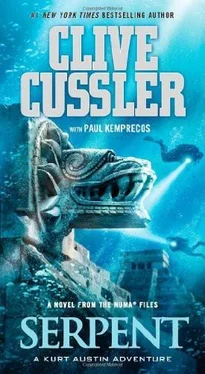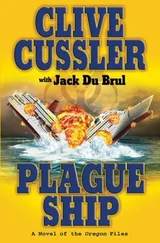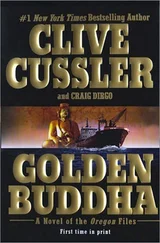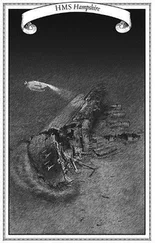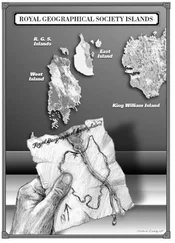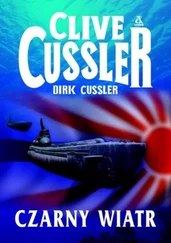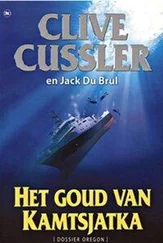They bounced along for nearly an hour. Chi followed a route that was entirely invisible to Gamay, and she was surprised when he announced they were at the end of the track. The professor maneuvered the vehicle around, taking down at least an acre of vegetation, pointed out, and switched off the motor.
"Time for a stroll in the woods."
Chi exchanged his straw hat for a Harvard baseball cap, worn with the visor facing backward so it wouldn't catch on branches. While he unloaded the packs Gamay changed from shorts into jeans that would protect her legs from thorns and briars. Chi slipped his arms through the straps of the rucksack holding their lunch, slung the shotgun over his shoulder, and hung the machete from a scabbard tucked into his belt. Gamay carried a second pack with the camera and notebooks. With a quick glance at the surfs position to get his bearings, he set off into the woods in a groundcovering scuttle.
Gamay had an athletic figure with long legs, small hips, and medium bust. She was a tomboy as a girl, always running with a gang of boys, building tree houses, playing baseball in the streets of Racine, Wisconsin. As a grown woman she became a fitness nut, deep into holistic medicine, and running and biking and hiking during family fourwheeling trips into the Virginia countryside. At five-ten, Gamay was nearly a foot taller than the professor. As lithe and fit as Gamay was, she had trouble keeping up with Chi. He seemed to melt through branches she had to push aside. His quiet passage through the forest made Gamay imagine she must sound like a cow crashing through the bushes. Only when Chi stopped to hack away with his machete at vines barring the way did she get a chance to catch her breath.
On one such halt, after they had climbed up a small hill, he pointed to broken pieces of limestone layering the ground.
"This is part of an old Mayan road. Raised paved causeways like this run between cities all over the Yucatan. Good as anything the Romans built. Traveling should be easier from now on."
His prediction proved true. Although the grass and bushes were still thick, the solid underpinning made for easier walking.
Before long they stopped again, and Chi indicated a low line of fallen stones that ran through the trees. "Those are the remains of a city wall. We're almost there."
A few minutes later the forest thinned, and they broke out of the trees into the dear. Chi slid the machete into its sheath.
"Welcome to Shangri-la."
They were at the edge of a plain about a half mile in diameter, covered with low bushes and broken here and there by trees. It was unremarkable except for odd-shaped, steep-sided mounds hidden under dense vegetation that rose from the grass between where she and the professor were standing and the tree line on the far side of the field.
Gamay blinked in the abrupt change from shade to bright sunlight. "It's not quite how I pictured utopia," she said, wiping the sweat from her eyes.
"Well, the neighborhood has gone downhill in the last thousand years or so," Dr. Chi lamented. "But you must admit it's quiet."
The only sound was their own breathing and the drone of a million insects. "I think the term is deathly quiet."
"What you see is the area immediately around the main one-acre plaza of a fairsized settlement. Buildings stretched out for three miles on each side with streets in between. Once this place bustled with little brown-skinned people like me. Priests in feathered regalia, soldiers, farmers, and merchants. Wood smoke hung in the air from hundreds of buts no different from my house. The sound of, infants crying. Drumbeats. All gone. It makes you think, doesn't it?" Chi's gaze was fixated as if the visions in his mind had come alive. "Well," he said, pulling himself back into the present. "I'll show you why I dragged you into the wilderness. Stay right behind me. There are holes all over the site that drop down to old dome-shaped cisterns. Some of them I've marked. I might have a hard time pulling you out. If you keep to the paths you'll be fine."
Warily eyeing the waist-high grass to either side of the rough trail, Gamay loped after the professor as he made his way across the field. They came to the foot of a mound covered with thick tendrils of vegetation. It was about thirty feet high and sixty feet at the base.
"This is the center of the plaza. Probably a temple to a minor god or king. The summit collapsed, which is what has saved the site from being discovered. The ruins are all below tree line and don't stick up out of the forest. You really can't see this place unless you're standing right on top of it."
"It's lucky you were hunting in the vicinity" Gamay ventured.
"It would be more dramatic if I stumbled out of the woods onto these ruins in pursuit of a partridge, but I cheated. I have a friend who works for NASA. A spy satellite mapping the rain forest saw a vague rectangular spot. I thought it looked interesting and took a closer look. That was nearly two years ago. I've been back a dozen times. On each visit I clear away more paths, and vegetation from the monuments and buildings. There are other ruins in the surrounding woods. I think it might turn out to be an important site. Now if you'll come this way"
Like a guide conducting a museum tour, Chi led Gamay along the path to a cylindrical structure that had been hidden behind a heavily grown mound. "I've devoted my last two visits solely to clearing away this building." They walked around the edifice, which was built of finely fitted brownish-gray stone blocks.
Gamay peered up at the rounded roof that had partially collapsed in on itself.
"Unusual architecture," she said. Another temple?"
Talking as he worked, Dr. Chi cut away the snaking vines that were boldly trying to reclaim the building. "No, this is actually a Mayan celestial observatory and time clock. Those ledges and window openings are. laid out so that the sun and stars would shine in according to the equinoxes and solstices. At the very top was an observatory chamber where astronomers could calculate the angles of stars. But here. This is what I wanted to show you."
He brushed away new vegetation from a frieze about a yard in width that ran around the lower part of the wall, then stepped back and invited Gamay to take a look. The frieze was carved at Mayan eye level, and Gamay had to bend low: It was a nautical scene. She ran her long fingers over a carving of a boat. The vessel had an open deck and a high stern and bow. The stem was elongated into what looked like a pointed battering ram. Billowing from the thick mast was a large square sail. There was no boom, the rope braids holding the top of the sail fastened to a permanent yard, lines sweeping fore and aft to the overhanging stem, a double steering oar. Seabirds flew overhead, and fish leaped from the water near the bow.
The craft bristled with so many spears it resembled the back of a porcupine. The weapons were in the hands, of men wearing what looked like football helmets. Other men rowed with long oars that were angled back along the side of the ship. There were twenty-five rowers, which meant there would have been a total of fifty, counting those on the side not visible. What appeared to be a row of shields hung off the rail. She used the human figures to estimate the approximate size of the craft at more than. one hundred feet.
Moving along the frieze she saw more warships and what appeared to be merchant vessels with fewer soldiers, the decks crowded with rectangular shapes that could have been boxes for goods. Men she assumed were ship's crew stood in the yardarm hauling on lines to trim the sail. In contrast to the helmeted men, they wore odd, pointed headgear. The motifs were varied, but this was clearly a flotilla of merchants being escorted by armed protectors.
Chi watched her walk around the building, an amused gleam in his dark eyes, and she realized he never intended to show her carvings of marine life. He wanted her to see the ship scene. She stopped at one ship and shook her head. On the bow of the boat was a carving of an animal.
Читать дальше
